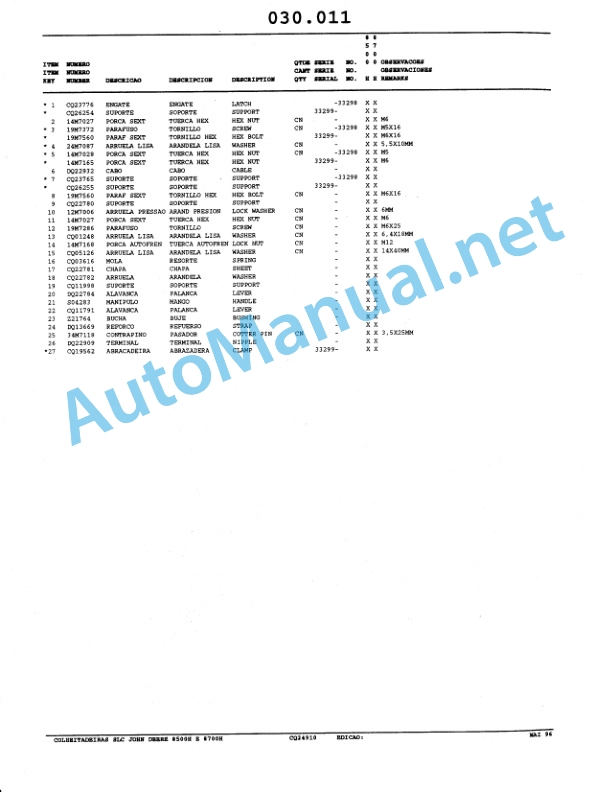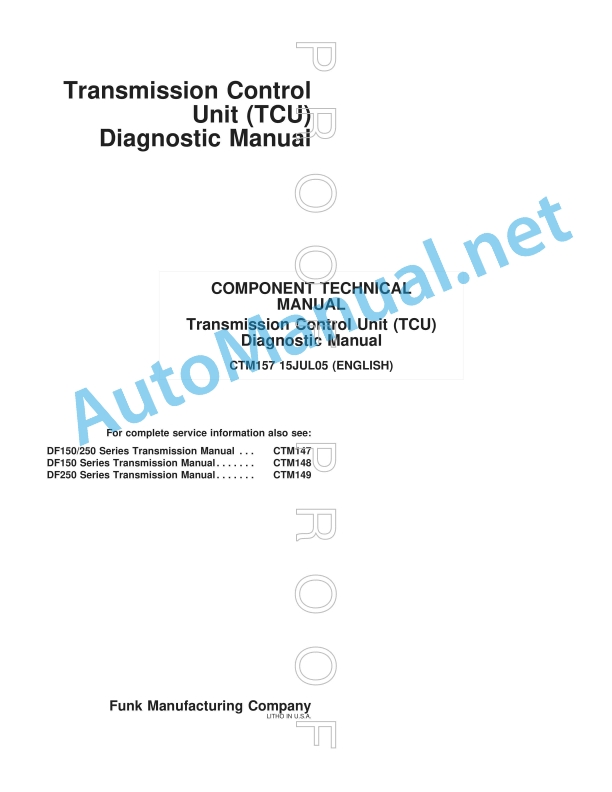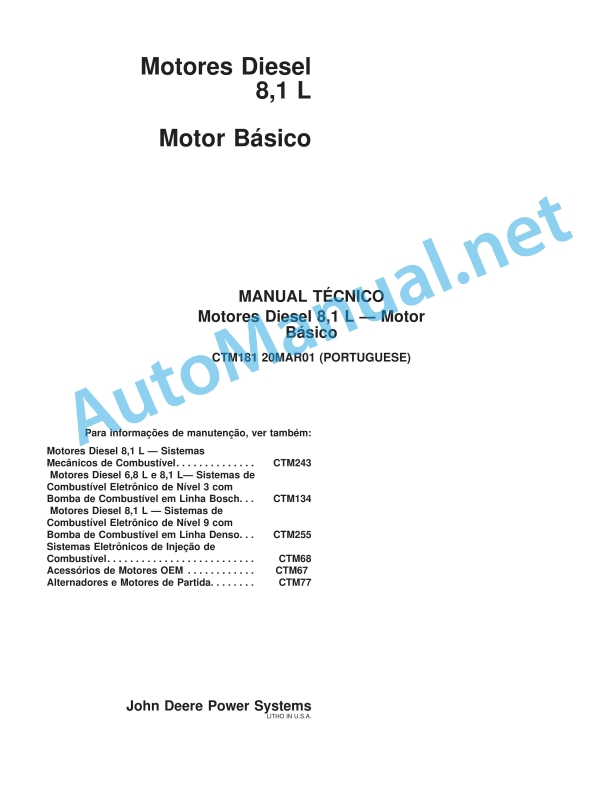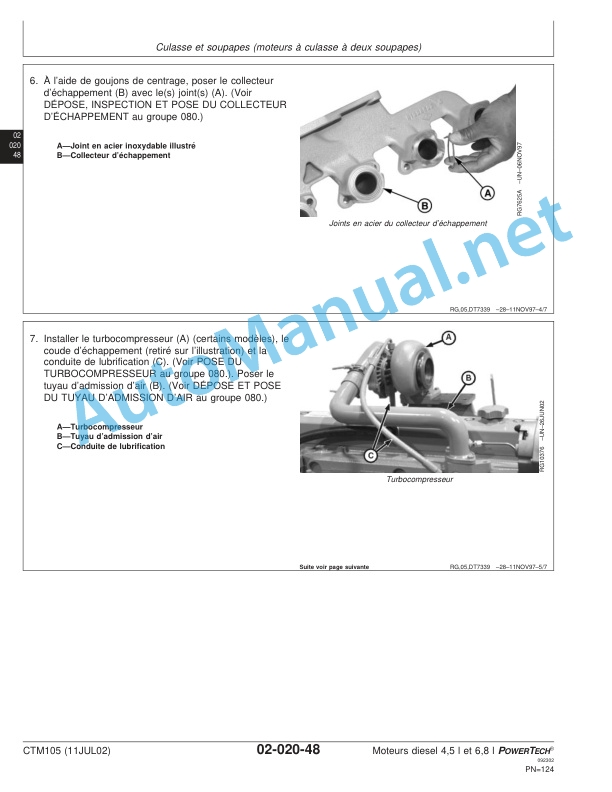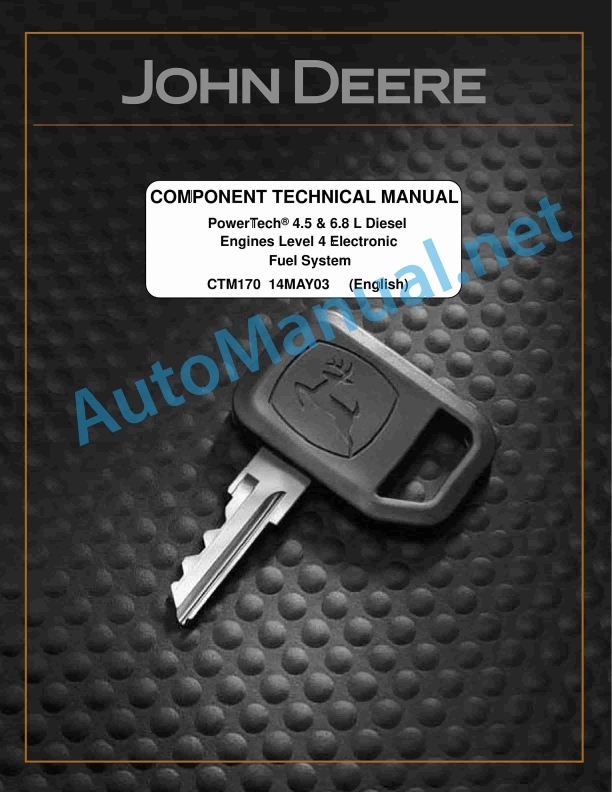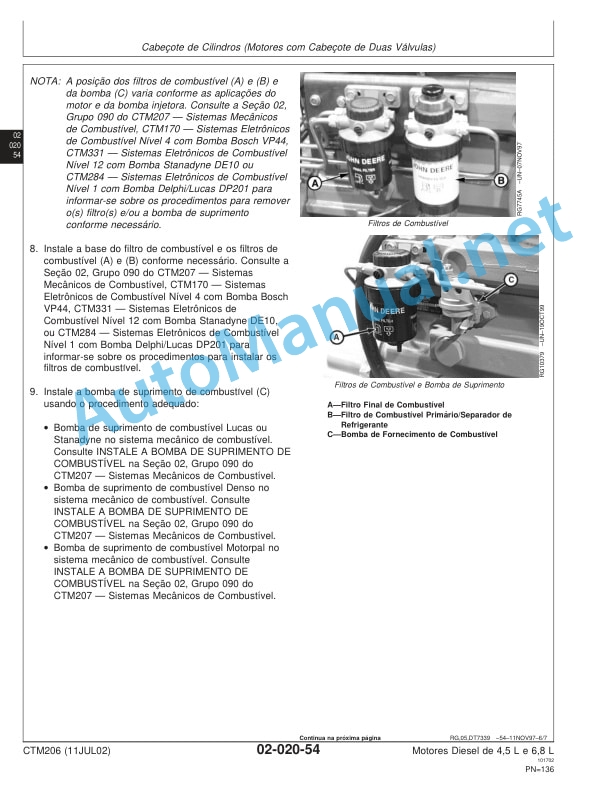Claas Liner 1700-1600 Twin (G17) Swathers Operator Manual ES
$50.00
- Model: Liner 1700-1600 Twin (G17) Swathers
- Type Of Manual: Operator Manual
- Language: ES
- Format: PDF(s)
- Size: 88.5 MB
File List:
00 2308 702 4.pdf
00 2308 702 4.pdf:
1. Introduction
1.1 Information regarding the instruction manual
1.1.1 Validity of the manual
1.1.2 Information about this instruction manual
1.1.3 Symbols and indications
1.1.4 Optional equipment
1.1.5 Qualified specialized workshop
1.1.6 Maintenance instructions
1.1.7 Information regarding warranty
1.1.8 Spare parts and technical issues
1.2 Proper application of the machine
1.2.1 Proper machine application
1.2.2 Logically foreseeable inappropriate application
2 Security
2.1 Recognize warning signs
2.1.1 Danger symbols
2.1.2 Keyword
2.2 Safety instructions
2.2.1 Meaning of the instruction manual
2.2.2 Observe graphic danger symbols and alarm indications
2.2.3 Requirements for all people working with the machine
2.2.4 Children in danger
2.2.5 Danger zones
2.2.6 Position yourself between the tractor and the machine
2.2.7 Accompanying persons
2.2.8 Couple the tractor with the machine
2.2.9 Risk of injury due to rotating shafts
2.2.10 Construction modifications
2.2.11 Optional equipment and spare parts
2.2.12 Control of the machine in operation
2.2.13 Operation only after correct commissioning
2.2.14 Technical status
2.2.15 Danger due to machine breakdowns
2.2.16 Comply with technical limit values
2.2.17 Danger due to coasting parts
2.2.18 Maintain functional protection devices
2.2.19 Personal protective equipment
2.2.20 Wear appropriate clothing
2.2.21 Remove dirt and loose objects
2.2.22 Prepare the machine for road traffic
2.2.23 Dangers when driving on the road and in the countryside
2.2.24 Park the machine safely
2.2.25 Parking without supervision
2.2.26 Unsuitable consumables
2.2.27 Safe handling of consumables and auxiliary materials
2.2.28 Environmental protection and waste disposal
2.2.29 Fire protection
2.2.30 Deadly electrical discharge through overhead lines
2.2.31 Behavior in the case of an overhead line voltage transfer and lightning strike
2.2.32 Liquids under pressure
2.2.33 Hot surfaces
2.2.34 Work only on the stopped machine
2.2.35 Maintenance work and repair work
2.2.36 Machine parts and lifted loads
2.2.37 Danger from welding work
2.3 Safety signage
2.3.1 Structure of graphic hazard symbols
2.3.2 Position of warning symbols on the machine
3 Machine Description
3.1 Summary and operation
3.1.1 Machine overview
3.1.2 Machine operating mode
3.2 Optional equipment
3.2.1 Additional swath cloth*
3.2.2 Hydraulic folding of the swath cloth*
3.2.3 Hydraulic adjustment of the swath cloth*
3.2.4 Hydraulic adjustment of rotor height*
3.2.5 Rear tandem axles*
3.2.6 Spare wheel 16×6.5-8*
3.2.7 Wheel weights*
3.2.8 Hydraulic connection parts 1 piece*
3.2.9 Insertable fork 8 components*
3.2.10 Legal technical equipment for Switzerland*
3.3 Identification plates and vehicle identification number
3.3.1 Machine identification plate
3.3.2 Machine identification plate
3.4 Machine information
3.4.1 Adhesive on the machine
4 Control and display instruments
4.1 Control elements
4.1.1 Windrower rotor
4.1.2 Hydraulic hose
4.1.3 Throttle check valve
4.1.4 Support leg
4.2 Indicator elements
4.2.1 Swath rotor chassis
4.2.2 Hooking device
5 Technical data
5.1 LINER 1700 TWIN / 1700
5.1.1 Dimensions
5.1.2 Weights
5.1.3 Tractor requirements
5.1.4 Version
5.1.5 Tire pressure
5.1.6 Lubricants
5.2 LINER 1600 TWIN / 1600
5.2.1 Dimensions
5.2.2 Weights
5.2.3 Tractor requirements
5.2.4 Version
5.2.5 Tire pressure
5.2.6 Lubricants
6 Preparation of the machine
6.1 Turn off the machine and secure it
6.1.1 Shut down and secure the machine and tractor
6.1.2 Secure the lifted machine
6.2 Adapt the tractor
6.2.1 Adapt the hydraulic performance of the tractor
6.2.2 Check the tractor ballast
Calculate the minimum front ballast
Calculate the minimum rear ballast
Calculate the actual load on the front axle
Calculate the actual total weight
Calculate the actual load on the rear axle
Calculation table
6.2.3 Check the tractor power take-off protection device
6.3 Adapt the machine
6.3.1 Check the length of the cardan shaft
Shortest working position of the cardan shaft
Longest working position of the cardan shaft
6.3.2 Adapt the length of the cardan shaft
6.3.3 Assemble the cardan shaft to the machine
6.3.4 Mount the wheel weights*
6.4 Hooking up the machine
6.4.1 Remove the security lock*
6.4.2 Attach the hitch bracket
6.4.3 Assemble the cardan shaft
6.4.4 Attach the safety chain*
6.4.5 Place the support leg upwards
6.4.6 Connect the hydraulic hose
6.4.7 Connect the hydraulic hose for the hydraulic folding of the swath canvas*
6.4.8 Connect the hydraulic hose for the hydraulic adjustment of the swath canvas*
6.4.9 Connect the hydraulic hoses for the hydraulic adjustment of the height of the rotors*
6.4.10 Insert the lighting cable*
6.4.11 Attach the pull rope
6.4.12 Save the shims
6.5 Unhooking the machine
6.5.1 Put the shims underneath
6.5.2 Unhook the pull rope
6.5.3 Remove the lighting cable*
6.5.4 Disconnect the hydraulic hose
6.5.5 Detach the hydraulic hose from the hydraulic folding of the swath canvas*
6.5.6 Disconnect the hydraulic hose from the hydraulic adjustment of the swath canvas*
6.5.7 Disconnect the hydraulic hoses from the hydraulic rotor height adjustment*
6.5.8 Remove the support leg
6.5.9 Unhooking the safety chain*
6.5.10 Dismantle the cardan shaft
6.5.11 Unhook the coupling bracket
6.5.12 Engage the safety lock*
6.6 Prepare for road traffic
6.6.1 Folding the protective stirrup
6.6.2 Remove the tine holder
6.6.3 Push the swath cloth inwards
6.6.4 Push the swath cloth inwards
6.6.5 Folding up the swath curtain with hydraulic folding of the swath curtain*
6.6.6 Insert the swath cloth with hydraulic adjustment of the swath cloth*
6.6.7 Push the additional swath curtain* inwards
Remove the additional swath canvas
6.6.8 Fold the machine into transport position
6.6.9 Insert the protective bars
6.6.10 Close the stopcock
6.6.11 Check before driving on the road
6.7 Prepare for use at work
6.7.1 Remove protective bars
6.7.2 Open the stopcock
6.7.3 Deploy the machine to the working position
6.7.4 Assemble the tine arms
6.7.5 Push the swath cloth out
6.7.6 Push the swath cloth out
6.7.7 Folding down the swath curtain with hydraulic folding of the swath curtain*
6.7.8 Removing the swath cloth with hydraulic wind cloth adjustment*
6.7.9 Pushing the additional swath curtain* out
Mount the additional swath canvas
6.7.10 Deploy the protective stirrup
6.8 Load the machine
6.8.1 Lift the machine
7 Management
7.1 Driving on the road
7.1.1 Circulation on public roads
7.2 Settings for use at work
7.2.1 Adjust the swath rotor
Basic adjustment of the left swath rotor
Basic adjustment of the right swath rotor
Basic adjustment of the right swath rotor
7.2.2 Adjust the raking height
Adjust the raking height with the crank
Adjust the raking height with the hydraulic rotor height adjustment*
7.2.3 Adjusting the row former
7.2.4 Adjusting the additional swath curtain*
7.2.5 Adjusting the swath cloth with hydraulic wind cloth adjustment*
7.2.6 Adjust the position for headboards
7.2.7 Adjust hydraulic sequential control
7.2.8 Modify the lifting speed
7.2.9 Adjust the steering stop
7.3 Use at work
7.3.1 Fold the machine into transport position
Fold the LINER 1700 TWIN into transport position
Fold the LINER 1600 TWIN into transport position
Fold the LINER 1700 / 1600 into transport position
7.3.2 Deploy the machine to the working position
7.3.3 Using the machine
7.3.4 Adapt the power take-off speed
7.3.5 Observe the stop angle
7.3.6 Adjust the placement of a row
Adjust rotor overlap
7.3.7 Adjust the placement of a row
7.3.8 Adjust the placement of two rows
Limit the output of the swath rotors
7.3.9 Adjust the placement of two rows
Limit the output of the swath rotors
7.3.10 Fix the swath canvas
7.3.11 Set the hydraulic folding of the swath canvas*
7.3.12 Raise the swath rotors to the headland position
8 Incident and solution
8.1 Chassis
8.1.1 Change the wheel on the transport chassis
8.1.2 Change the feeler wheel
8.1.3 Faults in the feeler wheels
8.1.4 The machine advances offset with respect to the tractor
Adjust the steering bar
8.1.5 Large tire wear
Adjust convergence
8.2 Hydraulic installation
8.2.1 Failures in the hydraulic installation
8.3 Windrower rotor
8.3.1 Faults in the swath rotors
8.4 Electrical installation
8.4.1 Faulty lighting
9 Maintenance
9.1 Summary of maintenance intervals
9.1.1 Before harvest
9.1.2 After the first 10 hours of service
9.1.3 After the first 50 hours of service
9.1.4 Every 8 hours of service or daily
9.1.5 Every 20 hours of service
9.1.6 Every 50 hours of service
9.1.7 Every 100 hours of service
9.1.8 Every 250 hours of service
9.1.9 Every 500 hours of service or annually
9.1.10 After harvest
9.2 Gearbox
9.2.1 Check the tightness of the gear
9.2.2 Check the main gear oil level
9.2.3 Change main gear oil
9.2.4 Check the main gear screws
9.2.5 Check the bevel gear oil level
9.2.6 Change bevel gear oil
9.2.7 Check the bevel gear screws
9.2.8 Check the swath gear oil level
9.2.9 Check the swath gear oil level
9.2.10 Change the swath gear oil
9.2.11 Change the swath gear oil
9.2.12 Check the swath gear screws
9.3 Clutch
9.3.1 Check the overload clutch
9.3.2 Ventilate the friction clutch
9.3.3 Clean the cardan shaft friction clutch
9.4 Cardan shaft
9.4.1 Maintenance of cardan shafts
9.4.2 Check the cardan shaft nuts
9.5 Chassis
9.5.1 Check tire pressure
9.5.2 Check the wheel nuts on the transport chassis
9.5.3 Check the wheel nuts on the swath rotor chassis
A = Left and right swath rotor, feeler wheels in front
B = Left swath rotor, rear feeler wheels
C = Right swath rotor, left rear feeler wheel
D = Right swath rotor, right rear feeler wheel
D = Right swath rotor, right rear feeler wheel
9.6 Hydraulic installation
9.6.1 Carry out maintenance on the hydraulic installation
9.6.2 Check the hydraulic hoses
9.6.3 Clean the area on the lift cylinder
9.6.4 Check the lifting cylinder screws
9.7 Framework
9.7.1 Check the hitch bar
9.7.2 Check the fixation of the chassis
9.8 Windrower rotor
9.8.1 Check the screws of the swath rotor attachment
9.8.2 Check the swath gear screws
9.8.3 Check the discharge springs
9.8.4 Check the spring
9.8.5 Check the tines
9.8.6 Check the slat plugs
9.9 Assembly and body parts
9.9.1 Eliminate crop remains
9.9.2 Clean the machine
9.9.3 Maintain the machine
9.9.4 Check the hydraulic adjustment screws of the swath canvas*
9.9.5 Check the fixing material
9.9.6 Prevent frost damage
9.10 Greasing scheme
9.10.1 Grease the lubrication points every 20 hours
9.10.2 Grease the lubrication points every 50 hours
9.10.3 Grease the grease points every 100 hours
9.10.4 Grease the grease points every 250 hours
10 Decommissioning and waste disposal
10.1 General information
10.1.1 Decommissioning and waste disposal
11 EC declaration of conformity
11.1 LINER 1700 TWIN / 1700 / 1600 TWIN / 1600
11.1.1 EC declaration of conformity
12 Technical dictionary and abbreviations
12.1 Terms and explanations
12.1.1 Technical vocabulary
12.1.2 Abbreviations
John Deere Parts Catalog PDF
John Deere Harvesters 8500 and 8700 Parts Catalog CPCQ24910 Spanish
John Deere Repair Technical Manual PDF
John Deere Repair Technical Manual PDF
John Deere Transmission Control Unit Component Technical Manual CTM157 15JUL05
John Deere Repair Technical Manual PDF
John Deere Repair Technical Manual PDF
John Deere Repair Technical Manual PDF
John Deere Repair Technical Manual PDF
John Deere Repair Technical Manual PDF
John Deere Repair Technical Manual PDF




